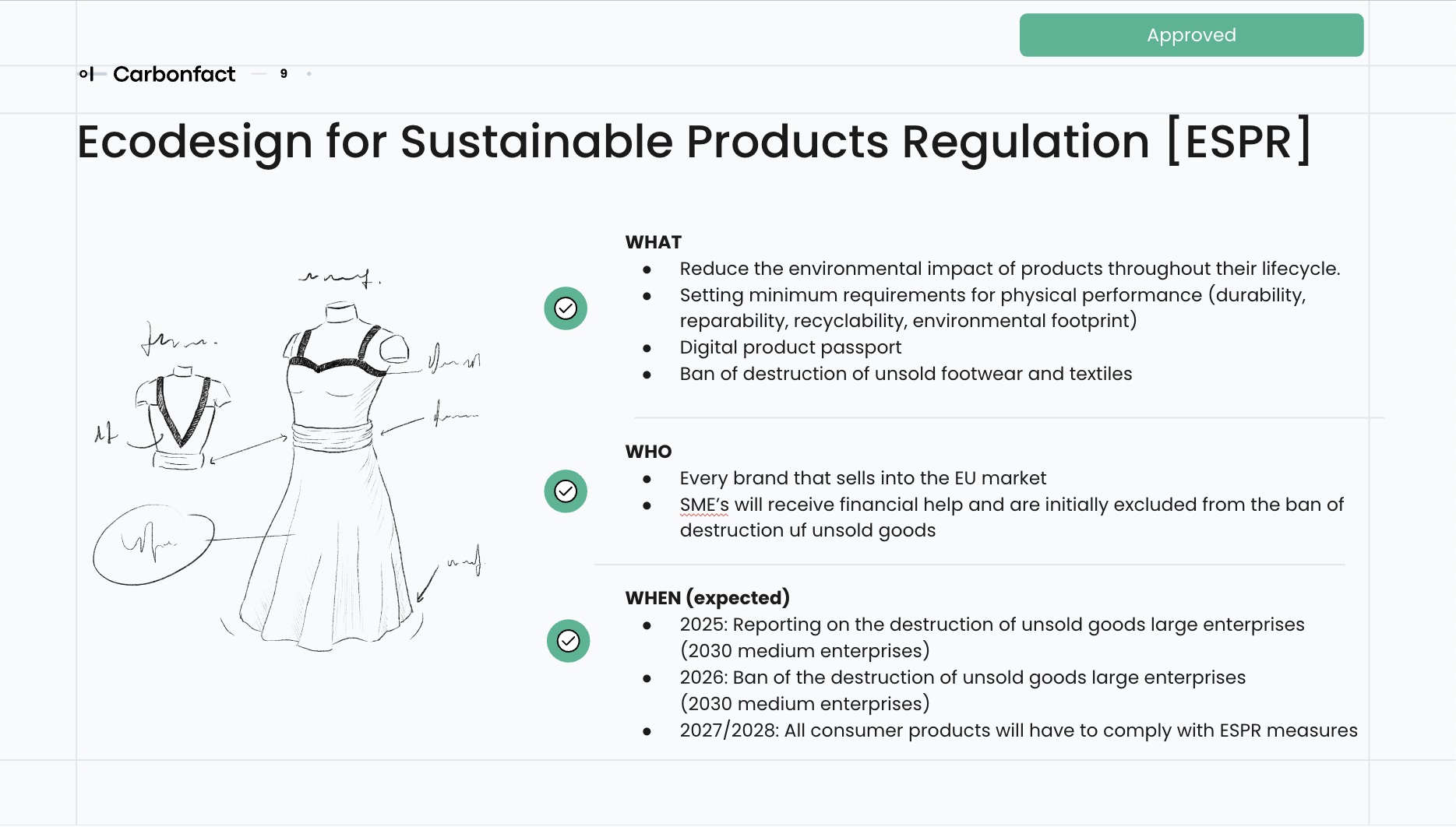"You Ask, We Answer" – brought to you by Carbonfact's Head of Science. Each week Laurent Vandepaer answers one of your questions about sustainable materials, manufacturing impact, and energy transition in the apparel and footwear industry.
Before joining Carbonfact, Laurent led the integration of LCA into the sustainability and innovation efforts at On and performed LCA for other brands like Arc'teryx. Laurent also worked for several years in research with a PhD focusing on the deployment of LCA at a large scale.
Question: We want to prepare as good as possible for the recently approved ESPR regulation. What will be the concrete recycled material share required and what are Laurent’s views on future clothing composition? Does he believe more in biobased fabrics or in textile-to-textile fabrics?
Asked by the Sustainability lead from a Sportswear brand
ESPR requirements for textiles
The ESPR (Ecodesign for Sustainable Products Regulation) itself is "framework legislation," meaning it just sets broader objectives but not yet concrete measures. It will still take a few years until the actual measures will be decided and become a requirement for our industry.
Currently, there are already negotiations regarding the ESPR Delegated Act concerning textiles, which will establish tailored market-entry requirements for the textile sector, aiming for publication by the end of 2026. Once an act is published, brands will have 18 months to prepare before the requirements enter into force. Concretely this means we can expect that apparel and footwear brands have to comply with ESPR measures in in 2027/2028.

While there are no specific requirements published yet for the ESPR, it is advisable to already incorporate recycled materials into your products. Recycled materials can reduce CO2 emissions by 10-40% at the raw material stage, depending on the fiber, technology, and GHG accounting approach.
Here are some things to pay attention to:
Recycled materials: Origin of waste is important
Some brands already have targets to reach 100% recycled content for certain materials like polyester and polyamide. One important parameter to look at is the origin of the waste. Currently, a lot of the waste feedstock for polyester comes from waste plastic bottles. In that case, it is being downcycled when it is transformed into textile and transformed into waste after its textile life (low recycling rate in textiles), while they could have made several material "loops" in the bottle industry.
Since plastic bottle waste is made of high-grade material (of superior quality, often having higher purity, strength, or performance compared to lower-grade materials), it is a highly demanded resource, and there is a constraint on the supply starting to appear. For this reason, it is important to use waste materials that are abundant and readily available, rather than using materials that other industries also need. This helps prevent shortages and also avoids the unintended effects of having other players rely more on virgin fossil material which would result in overall higher environmental impact at the broader system level.
Fiber-to-fiber recycling
In textiles, there is an excess of waste, and new technologies are emerging to achieve fiber-to-fiber recycling. Some interesting examples include transforming certain types of food and agricultural waste into textile fibers (for example, O My Bag uses Uppeal - a durable and low-impact leather alternative, made from residual apple waste). It's essential to consider the counterfactual—what would happen without recycling—to ensure we're diverting waste and not materials needed by another industry.
Fiber-to-fiber recycling might pose some challenges: One of them is that hazardous chemicals present in textile products remain in the product at the end of their useful life, even if they have been washed several times. The presence of hazardous chemicals requires additional processing to remove them.
However, advanced chemical recycling technologies can help solve this problem by producing virgin-like materials with lower environmental impact than traditional fossil-based methods. There is so much waste textile/plastics in circulation - without recycling streams - that this has the potential to be a significant source of material. While investigating these alternative recycling streams, I would always advocate to ask for a proper LCA to ensure that the environmental benefits are real.
What can you do now?
Preferred materials
According to Textile Exchange, preferred fibers and materials are defined as those that consistently reduce impacts on climate, nature, and people compared to conventional options, using a holistic approach to improve production systems.
Many brands are adopting these practices. Here are some examples:
Adore Me: Adore Me continues to measure product sustainability using the Adore Me Impact Matrix (AIM), a patent-pending tool assessing environmental sustainability based on design and manufacturing attributes. Developed by Adore Me's creation team, AIM leverages expertise in fiber selection, dyeing, and printing processes. Products are scored from 0 to 5 based on four key impact areas: Waste, Water, Fabrics, and Chemicals.
LANE EIGHT: When creating the HIIT Trainer, LANE EIGHT used a plant-based material from Tencel, derived from eucalyptus and cotton, to showcase the performance of the best natural materials.
New Balance: New Balance uses recycled midsole foam as their preferred midsole material.
Concrete already available options for textile-to-textile recycling
The example of this would be an agreement signed between Carbios and On, Patagonia, PUMA, and Salomon in 2022 to enhance the recyclability and circularity of their products. The two-year partnership aims to accelerate the adoption of Carbios' breakthrough biorecycling technology for the textile industry. Carbios and the four companies will also explore methods for recycling products, develop solutions for the collection of used polyester items, including sorting and dismantling technologies, and gather data on fiber-to-fiber recycling and circularity models.
Invest in new materials that are not fossil-origin
It is also important to acknowledge that if everyone starts recycling, supply might not meet demand due to inevitable waste (e.g., material deteriorates after several cycles). This means fresh inputs are necessary. The key is that this fresh material should not be of fossil origin. In addition to recycled materials, new supply could come from 2nd/3rd generation biobased materials or captured CO2. In investigating new solutions I would always advocate to ask for a proper LCA to ensure that the environmental benefits are real.
Think beyond materials
Recycled materials might reduce CO2 emissions by 10-40% at the raw material stage, depending on the fiber, technology, and GHG accounting approach. However, this reduction is further diluted at the product level due to additional processing stages. Therefore, while increasing recycled content helps, it is not sufficient to achieve ambitious GHG reduction targets. Other measures are also needed, such as:
- Increasing the use of renewable energy in the supply chain
- Phasing out coal boilers
- Decreasing waste during production processes (portion of the industrial footwear and apparel supply chain can be quite inefficient in terms of material use)
About Carbonfact
Carbonfact is Sustainability software, built specifically for apparel and footwear brands as well as manufacturers to measure the environmental impact of their products and take actionable steps to reduce their footprint. Our Product Impact Simulation tool enables you to run what-if scenarios on a product level, where you can experiment with different materials, suppliers, renewable electricity share, or transportation methods, and build concrete company-level decarbonization scenarios.
Do you have questions about sustainable practices, manufacturing impacts, or energy transitions in the apparel and footwear industry? We'd love to hear from you! Send us an email: youaskweanswer@carbonfact.com





 Lidia Lüttin
Lidia Lüttin
 Martin Daniel
Martin Daniel